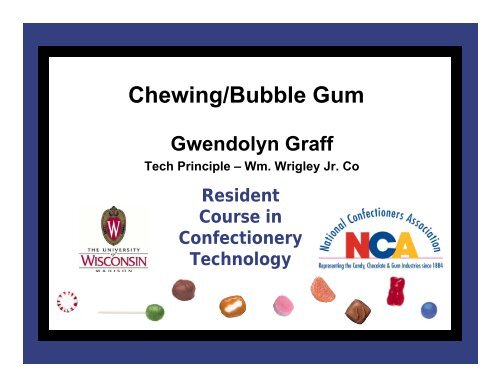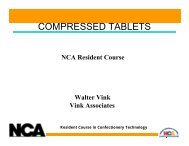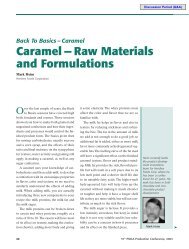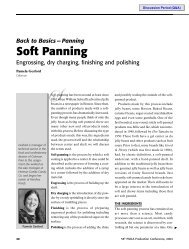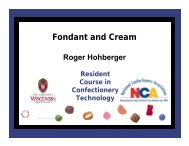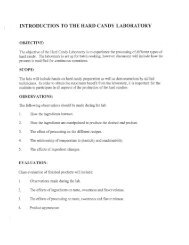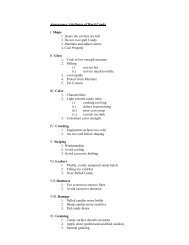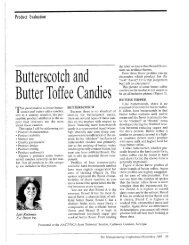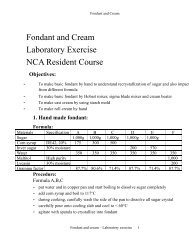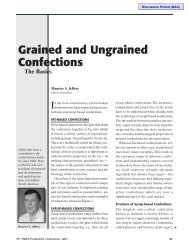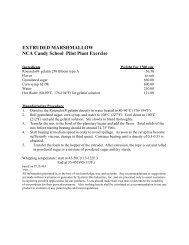Resident Course in Confectionery Technology - staging.files.cms ...
Resident Course in Confectionery Technology - staging.files.cms ...
Resident Course in Confectionery Technology - staging.files.cms ...
You also want an ePaper? Increase the reach of your titles
YUMPU automatically turns print PDFs into web optimized ePapers that Google loves.
Chew<strong>in</strong>g/Bubble Gum<br />
Gwendolyn Graff<br />
Tech Pr<strong>in</strong>ciple – Wm. Wrigley Jr. Co<br />
<strong>Resident</strong><br />
<strong>Course</strong> <strong>in</strong><br />
<strong>Confectionery</strong><br />
<strong>Technology</strong>
Gum History<br />
<strong>Resident</strong> <strong>Course</strong> <strong>in</strong> <strong>Confectionery</strong> <strong>Technology</strong>
GUM HISTORY<br />
• 50 A.D.: The ancient Greeks<br />
chewed tree res<strong>in</strong> – Mastiche<br />
(the term “masticate” comes from this)<br />
• 200 A.D.: The Maya Indians<br />
chewed chicle<br />
• 1800’s: American Indians<br />
chewed sap from trees<br />
<strong>Resident</strong> <strong>Course</strong> <strong>in</strong> <strong>Confectionery</strong> <strong>Technology</strong>
GUM HISTORY<br />
• 1848: The first commercial chew<strong>in</strong>g<br />
gums were manufactured - John B.<br />
Curtis manufactured State of Ma<strong>in</strong>e<br />
Pure Spruce Gum<br />
• 1869: William F<strong>in</strong>ley Semple obta<strong>in</strong>ed<br />
the first chew<strong>in</strong>g gum patent on<br />
December 28, 1869<br />
• 1869: Mexican General, Antonio<br />
Lopez de Santa Anna showed Chicle<br />
to Thomas Adams<br />
<strong>Resident</strong> <strong>Course</strong> <strong>in</strong> <strong>Confectionery</strong> <strong>Technology</strong>
GUM HISTORY<br />
• 1880: When William J. White<br />
added corn syrup, sugar and<br />
pepperm<strong>in</strong>t oil he called the<br />
new gum Yucatan<br />
• 1899: The merger of six<br />
manufacturers to form the Chew<strong>in</strong>g<br />
Gum Trust, later known as the<br />
American Chicle Co.<br />
– William Wrigley Jr. was asked to jo<strong>in</strong> <strong>in</strong><br />
the merger but refused<br />
• 1899: Frank E. Barbour son-<strong>in</strong>-law of<br />
the president of Beech-Nut Pack<strong>in</strong>g<br />
started Beechnut Gum<br />
<strong>Resident</strong> <strong>Course</strong> <strong>in</strong> <strong>Confectionery</strong> <strong>Technology</strong>
GUM HISTORY<br />
• 1906: Frank Fleer <strong>in</strong>vented a form of<br />
bubble gum known as Blibber-Blubber<br />
Gum,<br />
• 1917: Chew<strong>in</strong>g gum was <strong>in</strong>cluded <strong>in</strong><br />
soldier’s ration. The American Red<br />
Cross distributed over 4 ½ million<br />
packs<br />
• 1927: Holger Sorenson [Dandy’s founder]<br />
noticed chew<strong>in</strong>g gum at a London<br />
exhibition; 1st Danish chew<strong>in</strong>g gum<br />
produced; Vejle Tyggegummi<br />
<strong>Resident</strong> <strong>Course</strong> <strong>in</strong> <strong>Confectionery</strong> <strong>Technology</strong>
GUM HISTORY<br />
• 1937: White Laboratories<br />
<strong>in</strong>troduce<br />
– Aspergum; an analgesic gum<br />
conta<strong>in</strong><strong>in</strong>g aspir<strong>in</strong><br />
– Pheenam<strong>in</strong>t; a laxative gum<br />
conta<strong>in</strong><strong>in</strong>g phenylthal<strong>in</strong>e<br />
– Chooz; an antacid gum<br />
conta<strong>in</strong><strong>in</strong>g calcium carbonate<br />
• 1946: The Mexican<br />
government nationalized the<br />
chicle <strong>in</strong>dustry<br />
<strong>Resident</strong> <strong>Course</strong> <strong>in</strong> <strong>Confectionery</strong> <strong>Technology</strong>
GUM HISTORY<br />
• Claude E. Parfet [formerly the European<br />
general agent for the Beech-Nut Co] formed<br />
Krema-Hollywood Chew<strong>in</strong>g Gum <strong>in</strong><br />
France<br />
• 1948: Bruno Petrulis’ company,<br />
Amurol Products Company<br />
{Naperville, IL} manufactures a SF gum<br />
• V<strong>in</strong>cent Ciccone [production manager of<br />
Charms] conceived the idea<br />
of <strong>in</strong>sert<strong>in</strong>g a bubble gum<br />
fill<strong>in</strong>g <strong>in</strong> a lollipop<br />
<strong>Resident</strong> <strong>Course</strong> <strong>in</strong> <strong>Confectionery</strong> <strong>Technology</strong>
GUM HISTORY<br />
• 1964: After test market<strong>in</strong>g for two years,<br />
American Chicle Co. <strong>in</strong>troduced their<br />
first sugar-free gum; Trident<br />
• 1990's: Functional chew<strong>in</strong>g<br />
gums, lead by Pharmacia’s<br />
Nicorette Gum, became an<br />
<strong>in</strong>dustry growth segment<br />
• 1996: Hershey Foods acquires Leaf<br />
North America <strong>Confectionery</strong><br />
• 1998: Concord Confections Inc. acquires<br />
Fleer Corporation<br />
<strong>Resident</strong> <strong>Course</strong> <strong>in</strong> <strong>Confectionery</strong> <strong>Technology</strong>
GUM HISTORY<br />
• 2001: Hershey Foods Corp. acquires<br />
Nabisco’s Sugarless Gum and m<strong>in</strong>t<br />
bus<strong>in</strong>esses<br />
• 2002: Cadbury Schweppes acquires<br />
Dandy Chew<strong>in</strong>g Gum<br />
• 2002: The Danish Gum Company<br />
changes its name to Guml<strong>in</strong>k<br />
• 2002: Cadbury Schweppes acquires<br />
Adams Brands<br />
<strong>Resident</strong> <strong>Course</strong> <strong>in</strong> <strong>Confectionery</strong> <strong>Technology</strong>
GUM HISTORY<br />
• 2003: Concord Confections Inc.<br />
acquires Philadelphia Chew<strong>in</strong>g Gum<br />
• 2004: Wm. Wrigley Jr. Company<br />
acquires Joyco Group and Cafosa<br />
Gum<br />
• 2004: Tootsie Roll Industries<br />
acquires Concord Confections<br />
• 2007: Cadbury buys Intergum<br />
[Turkey]<br />
• 2008: MARS purchases Wrigley<br />
<strong>Resident</strong> <strong>Course</strong> <strong>in</strong> <strong>Confectionery</strong> <strong>Technology</strong>
Gum Base<br />
<strong>Resident</strong> <strong>Course</strong> <strong>in</strong> <strong>Confectionery</strong> <strong>Technology</strong>
What is Gum Base?<br />
The <strong>in</strong>gredient that separates gum from<br />
other confections<br />
n.: thermoplastic material that rema<strong>in</strong>s <strong>in</strong><br />
the mouth; <strong>in</strong>digestible<br />
Chew<strong>in</strong>g gum base is an <strong>in</strong>soluble, semicrystall<strong>in</strong>e,<br />
non-nutritive, masticatory<br />
substance formulated to provide a<br />
pleasant chew<strong>in</strong>g experience and gradual<br />
release of flavors and sweeteners<br />
<strong>Resident</strong> <strong>Course</strong> <strong>in</strong> <strong>Confectionery</strong> <strong>Technology</strong>
What is Gum Base?<br />
Chew<strong>in</strong>g Gum Base<br />
US FDA 21CFR172.615<br />
A food additive consist<strong>in</strong>g of one or more of the<br />
follow<strong>in</strong>g substances that meet the specifications<br />
and limitations prescribed <strong>in</strong> the paragraph and<br />
used <strong>in</strong> amounts not to exceed those required to<br />
produce the <strong>in</strong>tended physical or other technical<br />
effect.<br />
<strong>Resident</strong> <strong>Course</strong> <strong>in</strong> <strong>Confectionery</strong> <strong>Technology</strong>
Slabs<br />
Pellets<br />
(various shapes)<br />
Sheets<br />
<strong>Resident</strong> <strong>Course</strong> <strong>in</strong> <strong>Confectionery</strong> <strong>Technology</strong>
Components<br />
Purified Elastomeric Polymers<br />
Res<strong>in</strong>s<br />
Texturizers<br />
Micro Waxes<br />
Paraff<strong>in</strong>s<br />
Emulsifiers<br />
Hydrogenated Oils<br />
Antioxidants<br />
<strong>Resident</strong> <strong>Course</strong> <strong>in</strong> <strong>Confectionery</strong> <strong>Technology</strong>
Substances Specifications<br />
Butadiene-Styrene Base Polymer<br />
Rubber<br />
Isobutylene Isoprene Base polymer<br />
copolymer (Butyl<br />
Rubber)<br />
Petroleum wax Comply<strong>in</strong>g with Sec. 172.886.<br />
Synthetic petroleum Comply<strong>in</strong>g with Sec. 172.888.<br />
Polyethylene Molecular weight 2,000-21,000.<br />
Polyisobutylene M<strong>in</strong>imum molecular weight 37,000 (Flory).<br />
Polyv<strong>in</strong>yl acetate Molecular weight, m<strong>in</strong>imum 2,000<br />
Synthetic paraff<strong>in</strong> wax Synthesized by Fischer-Tropsch process from carbon<br />
monoxide and hydrogen which are catalytically converted<br />
to a mixture of paraff<strong>in</strong> hydrocarbon. Lower molecular<br />
weight fractions are removed by distillation. The residue<br />
is hydrogenated and further treated<br />
<strong>Resident</strong> <strong>Course</strong> <strong>in</strong> <strong>Confectionery</strong> <strong>Technology</strong>
Substance Specifications<br />
Lanol<strong>in</strong><br />
Rice bran wax Comply<strong>in</strong>g with Sec.<br />
172.890<br />
Stearic acid Comply<strong>in</strong>g with Sec.<br />
Sodium and<br />
potassium stearates<br />
172.860.<br />
Comply<strong>in</strong>g with Sec.<br />
172.863.<br />
<strong>Resident</strong> <strong>Course</strong> <strong>in</strong> <strong>Confectionery</strong> <strong>Technology</strong>
Substance Specifications<br />
Glycerol ester of<br />
partially dimerized<br />
ros<strong>in</strong><br />
Glycerol ester of<br />
partially<br />
hydrogenated gum<br />
or wood ros<strong>in</strong>.<br />
Glycerol ester of<br />
polymerized ros<strong>in</strong><br />
Hav<strong>in</strong>g an acid number of 3-8, a drop-<br />
soften<strong>in</strong>g po<strong>in</strong>t of 109° C-119° C, and a color<br />
of M or paler.<br />
Hav<strong>in</strong>g an acid number of 3-10, a drop-<br />
soften<strong>in</strong>g po<strong>in</strong>t of 79°C-88°C, and a color of N<br />
or paler.<br />
Hav<strong>in</strong>g an acid number of 3-12, a melt<strong>in</strong>g-po<strong>in</strong>t<br />
range 80°C-126°C, and a color of M or paler.<br />
<strong>Resident</strong> <strong>Course</strong> <strong>in</strong> <strong>Confectionery</strong> <strong>Technology</strong>
Substance Specifications<br />
Glycerol ester of<br />
gum ros<strong>in</strong><br />
Glycerol ester of<br />
tall oil ros<strong>in</strong><br />
Glycerol ester of<br />
wood ros<strong>in</strong><br />
Hav<strong>in</strong>g an acid number of 5-9, a drop-soften<strong>in</strong>g<br />
po<strong>in</strong>t of 88°C-96°C, and a color of N or paler.<br />
The ester is purified by steam stripp<strong>in</strong>g.<br />
Hav<strong>in</strong>g an acid number of 2-12, a soften<strong>in</strong>g<br />
po<strong>in</strong>t (r<strong>in</strong>g and ball) of 80°C-88°C, and a color<br />
of N or paler. The ester is purified by steam<br />
stripp<strong>in</strong>g.<br />
Hav<strong>in</strong>g an acid number of 3-9, a drop-soften<strong>in</strong>g<br />
po<strong>in</strong>t of 88°C-96°C, and a color of N or paler.<br />
The ester is purified by steam stripp<strong>in</strong>g.<br />
<strong>Resident</strong> <strong>Course</strong> <strong>in</strong> <strong>Confectionery</strong> <strong>Technology</strong>
Substance Specifications<br />
Methyl ester of<br />
ros<strong>in</strong>, partially<br />
hydrogenated<br />
Pentaerythritol<br />
ester of partially<br />
hydrogenated gum<br />
or wood res<strong>in</strong><br />
Pentaerythritol<br />
ester of gum or<br />
wood ros<strong>in</strong>.<br />
Hav<strong>in</strong>g an acid number of 4-8, a refractive<br />
<strong>in</strong>dex of 1.5170-1.5205 at 20°C, and a<br />
viscosity of 23-66 poises at 25°C. The ester is<br />
purified by steam stripp<strong>in</strong>g.<br />
Hav<strong>in</strong>g an acid number of 7-18, a drop-<br />
soften<strong>in</strong>g po<strong>in</strong>t of 102°C-110° C, and a color<br />
of K or paler.<br />
Hav<strong>in</strong>g an acid number of 6-16, a drop-<br />
soften<strong>in</strong>g po<strong>in</strong>t of 109°C-116°C, and a color of<br />
M or paler.<br />
<strong>Resident</strong> <strong>Course</strong> <strong>in</strong> <strong>Confectionery</strong> <strong>Technology</strong>
Substance Specifications<br />
Synthetic Terpene<br />
Res<strong>in</strong><br />
Natural Terpene<br />
Res<strong>in</strong><br />
Consist<strong>in</strong>g of polymers of α-p<strong>in</strong>ene, β-p<strong>in</strong>ene,<br />
and/or dipentene; acid value less than 5,<br />
saponification number less than 5, and color<br />
less than 4 on the Gardner scale as measured<br />
<strong>in</strong> 50 percent m<strong>in</strong>eral spirit solution.<br />
Consist<strong>in</strong>g of polymers of α-p<strong>in</strong>ene; soften<strong>in</strong>g<br />
po<strong>in</strong>t m<strong>in</strong>imum 155°C, determ<strong>in</strong>ed by U.S.P.<br />
closed- capillary method, United States<br />
Pharmacopeia XX (1980) (page 961).<br />
<strong>Resident</strong> <strong>Course</strong> <strong>in</strong> <strong>Confectionery</strong> <strong>Technology</strong>
Substance Specifications<br />
Butylated Not to exceed antioxidant content of 0.1%<br />
hydroxyanisole when used alone or <strong>in</strong> any comb<strong>in</strong>ation.<br />
Butylated Not to exceed antioxidant content of 0.1%<br />
hydroxytoluene when used alone or <strong>in</strong> any comb<strong>in</strong>ation.<br />
<strong>Resident</strong> <strong>Course</strong> <strong>in</strong> <strong>Confectionery</strong> <strong>Technology</strong>
In addition to the substances listed, chew<strong>in</strong>g<br />
gum base may also <strong>in</strong>clude substances<br />
generally recognized as safe <strong>in</strong> food, such as<br />
hydrogenated or partially hydrogenated oils,<br />
lecith<strong>in</strong>, mono & di-glycerides, etc.<br />
<strong>Resident</strong> <strong>Course</strong> <strong>in</strong> <strong>Confectionery</strong> <strong>Technology</strong>
Gum Base FAQ’s<br />
What makes bubble gum bases different than chew<strong>in</strong>g<br />
gum bases?<br />
ability to make bubbles,<br />
higher levels of rubbers or polymers and/or,<br />
higher molecular weight polymers,<br />
lower base levels than <strong>in</strong> chew<strong>in</strong>g gums.<br />
What makes a gum base regular or acid compatible?<br />
m<strong>in</strong>eral adjuncts<br />
Calcium Carbonate,<br />
Food Grade Talc,<br />
Dicalcium Phosphate<br />
These modify the mouth feel & facilitate the process<strong>in</strong>g of gum<br />
bases<br />
<strong>Resident</strong> <strong>Course</strong> <strong>in</strong> <strong>Confectionery</strong> <strong>Technology</strong>
Gum Base FAQ’s<br />
How do Gum Bases vary <strong>in</strong> quality?<br />
Texturizers are lower cost than the other components used <strong>in</strong><br />
gum base. Higher texturizer levels effect:<br />
Price<br />
Chew<strong>in</strong>g character & mouth feel<br />
Bubble character & size<br />
Process<strong>in</strong>g<br />
Chew<strong>in</strong>g gum base<br />
high quality chew<strong>in</strong>g gum base,<br />
texturizer levels 5-20%,<br />
economical chew<strong>in</strong>g gum base,<br />
Levels can be as high as 45-55%.<br />
Bubble gum base<br />
Texturizers from 20% to 65%,<br />
higher levels be<strong>in</strong>g the more economical grade<br />
higher levels of texturizer reduce stretch<br />
higher levels of texturizers reduce bolus (cud) size<br />
<strong>Resident</strong> <strong>Course</strong> <strong>in</strong> <strong>Confectionery</strong> <strong>Technology</strong>
Gum Base FAQ’s<br />
What is a “non-stick<strong>in</strong>g” gum base?<br />
Chew<strong>in</strong>g gums that have no tack to dental work<br />
Bubble Gums that have no tack to lips & face<br />
Why are Antioxidants used <strong>in</strong> gum bases?<br />
Antioxidants, such as BHT, BHA or Tocopherols [Vit E] are<br />
necessary to protect the components of the gum base from<br />
oxidation<br />
Gum bases can be made without antioxidants, but special stable<br />
components are used<br />
<strong>Resident</strong> <strong>Course</strong> <strong>in</strong> <strong>Confectionery</strong> <strong>Technology</strong>
Gum Base FAQ’s<br />
What are the different Gum Base types?<br />
Because chew<strong>in</strong>g gums and bubble gums are sold <strong>in</strong> different<br />
formats gum bases need to be different:<br />
Sticks & Tabs<br />
Dragées (Pellets)<br />
Hollow balls<br />
Cut & wrap<br />
Tubes<br />
Etc.<br />
<strong>Resident</strong> <strong>Course</strong> <strong>in</strong> <strong>Confectionery</strong> <strong>Technology</strong>
Bubble<br />
Chew<strong>in</strong>g<br />
Non Acid<br />
Compatible<br />
Acid<br />
Compatible<br />
Non Acid<br />
Compatible<br />
Acid<br />
Compatible<br />
Conventional Bubble Gums<br />
Non Stick<strong>in</strong>g Bubble Gums<br />
Conventional Bubble Gums<br />
Non Stick<strong>in</strong>g Bubble Gums<br />
Conventional Chew<strong>in</strong>g Gums<br />
Non Stick<strong>in</strong>g to dentures<br />
Conventional Chew<strong>in</strong>g Gums<br />
Non Stick<strong>in</strong>g to dentures<br />
<strong>Resident</strong> <strong>Course</strong> <strong>in</strong> <strong>Confectionery</strong> <strong>Technology</strong><br />
Quality and<br />
Texture Levels
Gum Ingredients<br />
<strong>Resident</strong> <strong>Course</strong> <strong>in</strong> <strong>Confectionery</strong> <strong>Technology</strong>
Gum Ingredients – Gum Base<br />
Gum Base – {Insoluble} [~17-30% of formula]<br />
Function <strong>in</strong> gum:<br />
to provide a pleasant chew<strong>in</strong>g experience and gradual release of flavors<br />
and sweeteners.<br />
B<strong>in</strong>ds <strong>in</strong>gredients together to form cohesive cud<br />
Different types can affect flavor release, process<strong>in</strong>g, bubble blow<strong>in</strong>g etc.<br />
Interactions with Flavors <strong>in</strong> the formula cause base to plasticize (soften)<br />
Can also have <strong>in</strong>teractions with acid – result<strong>in</strong>g <strong>in</strong> process<strong>in</strong>g problems, as<br />
well as stability issues<br />
<strong>Resident</strong> <strong>Course</strong> <strong>in</strong> <strong>Confectionery</strong> <strong>Technology</strong>
Gum Ingredients – Fillers/Texturizers<br />
M<strong>in</strong>eral Fillers – {Insoluble} [if at all,
Gum Ingredients – Flavors<br />
Flavors – [~0.75-3 % of gum formula]<br />
Function <strong>in</strong> gum:<br />
Provides taste to gum<br />
Can affect texture thru plasticization of base<br />
The flavor to base ratio is often used as a tool <strong>in</strong> formulation. This ratio is<br />
critical to give the desired flavor release and chew<strong>in</strong>g characteristics<br />
The carrier/solvent the flavor is <strong>in</strong> is important – as different types can<br />
plasticize the gum differently<br />
Gum flavors are much more concentrated than candy flavors<br />
Significant amounts of certa<strong>in</strong> flavors will dissolve <strong>in</strong> base and never release<br />
Some flavors are very volatile and release quickly from base depend<strong>in</strong>g on the<br />
composition of the base and flavor. Process<strong>in</strong>g temperatures need to be held <strong>in</strong><br />
check<br />
Encapsulated versions are used to protect flavor and provide either quick<br />
release or delayed release<br />
<strong>Resident</strong> <strong>Course</strong> <strong>in</strong> <strong>Confectionery</strong> <strong>Technology</strong>
Gum Ingredients – Flavors (cont.)<br />
Triacet<strong>in</strong> & Oil<br />
Function <strong>in</strong> Gum:<br />
Gumbase softeners<br />
Provide additional plasticiz<strong>in</strong>g to gum<br />
Used to supplement flavor plasticiz<strong>in</strong>g to achieve a desired chew<br />
character<br />
Too high of levels can result <strong>in</strong> process<strong>in</strong>g issues or gum dissolv<strong>in</strong>g when<br />
chewed<br />
If <strong>in</strong> formula, and too little was added – gum could exhibit process<strong>in</strong>g<br />
problems, or firm chew texture<br />
<strong>Resident</strong> <strong>Course</strong> <strong>in</strong> <strong>Confectionery</strong> <strong>Technology</strong>
Gum Ingredients – Bulk<strong>in</strong>g Agents<br />
Bulk<strong>in</strong>g Agents – [~70-85% of gum formula]<br />
Examples:<br />
- Carbohydrates (Sugar)<br />
• Sugar<br />
• Dextrose<br />
• Corn Syrup<br />
- Polyols (Sugar-free)<br />
• Sorbitol<br />
• Maltitol<br />
• Mannitol<br />
• Xylitol<br />
• Maltitol Syrup<br />
• Hydrogenated Starch Hydrolysates<br />
<strong>Resident</strong> <strong>Course</strong> <strong>in</strong> <strong>Confectionery</strong> <strong>Technology</strong>
Gum Ingredients – Bulk<strong>in</strong>g Agents (cont.)<br />
Function <strong>in</strong> gum:<br />
Provide body, sweetness, cool<strong>in</strong>g (<strong>in</strong> the case of Xylitol)<br />
Effect flavor release, shelf life, & process<strong>in</strong>g<br />
Crystal morphology, % solids and DE <strong>in</strong> syrups can affect all aspects of<br />
chew<strong>in</strong>g gum<br />
Potentiate flavor.<br />
Syrups often aid <strong>in</strong> mix<strong>in</strong>g, but can cause mix<strong>in</strong>g problems that result <strong>in</strong><br />
longer mix<strong>in</strong>g times:<br />
• If added too early – can prevent base from schmear<strong>in</strong>g<br />
• If added too late – mix will be crumbly<br />
The particle size of dry bulk<strong>in</strong>g agents is usually specified – the p.s. is<br />
critical to both the process<strong>in</strong>g as well as the f<strong>in</strong>al products’ sensory profile<br />
• If too large – may make gum gritty or mix more soupy<br />
• If too f<strong>in</strong>e – may cause clump<strong>in</strong>g, dry out gum or cause sensory<br />
changes (shorter sweetness duration)<br />
<strong>Resident</strong> <strong>Course</strong> <strong>in</strong> <strong>Confectionery</strong> <strong>Technology</strong>
Gum Ingredients - Softeners<br />
Softeners/Emulsifiers – [~1-6 % of gum formula]<br />
Examples:<br />
- Glycer<strong>in</strong><br />
- Lecith<strong>in</strong><br />
- Glycerol monostearate<br />
Function <strong>in</strong> gum formula:<br />
Used to soften <strong>in</strong>itial chew<br />
Serve as a humectant (glycer<strong>in</strong>) to regulate loss and ga<strong>in</strong> of H 2 O<br />
Serve as emulsifiers - allow hygroscopic and hydrophobic <strong>in</strong>gredients to be<br />
miscible <strong>in</strong> one another<br />
Assist <strong>in</strong> mix<strong>in</strong>g – make gum easier to work with<br />
Extend softness of gum dur<strong>in</strong>g storage, distribution and sales<br />
Can affect process<strong>in</strong>g<br />
• Some of them lubricate and can help to achieve cleaner scor<strong>in</strong>g<br />
Can affect shelf life<br />
• Help ma<strong>in</strong>ta<strong>in</strong> softer <strong>in</strong>itial chew texture<br />
Can affect tack and flavor release<br />
<strong>Resident</strong> <strong>Course</strong> <strong>in</strong> <strong>Confectionery</strong> <strong>Technology</strong>
Gum Ingredients - Acids<br />
Acids – [0-2 % of gum formula]<br />
Examples:<br />
- Citric Acid<br />
• Tart, early high impact, brightens up flavor<br />
- Fumaric Acid<br />
• “Clean” tartness<br />
- Malic Acid<br />
• Smooth tart taste that builds up & dim<strong>in</strong>ishes without a burst<br />
Function <strong>in</strong> gum:<br />
Provides tartness<br />
Usually used to enhance fruit flavors<br />
<strong>Resident</strong> <strong>Course</strong> <strong>in</strong> <strong>Confectionery</strong> <strong>Technology</strong>
Raw Materials – Acids (cont.)<br />
<strong>Resident</strong> <strong>Course</strong> <strong>in</strong> <strong>Confectionery</strong> <strong>Technology</strong>
Raw Materials – Acids (cont.)<br />
Acids can <strong>in</strong>teract with other <strong>in</strong>gredients (such as sweeteners and flavors) to enhance<br />
or degrade sensorial properties of gum.<br />
Acids must be stored properly to keep them from block<strong>in</strong>g / bridg<strong>in</strong>g<br />
Acids may fade or bleach some colors (most prevalent <strong>in</strong> red colors)<br />
When a formula conta<strong>in</strong>s acid, it should be made with a gum base that only conta<strong>in</strong>s<br />
talc as its filler - Gum bases conta<strong>in</strong><strong>in</strong>g Calcium Carbonate as a filler should not<br />
be used. Thorough clean-outs need to be conducted of products that conta<strong>in</strong>ed any<br />
CaCO 3 gum base before the gum is made<br />
Care must be taken to avoid cross contam<strong>in</strong>ation of acid with alkal<strong>in</strong>e <strong>in</strong>gredients –<br />
such as CaCO 3 . This filler will react with the acid if mixed. As a result:<br />
The acid is consumed as it reacts with the Calcium Carbonate<br />
The base is compromised and the resultant gum tends to be tacky, or can fall apart<br />
when chewed<br />
<strong>Resident</strong> <strong>Course</strong> <strong>in</strong> <strong>Confectionery</strong> <strong>Technology</strong>
Raw Materials - HIS<br />
High Intensity Sweeteners ($$$) - [~0.005 - 1 % of gum formula]<br />
Examples:<br />
• Aspartame<br />
• Neotame<br />
• Ace-K<br />
• Sucralose<br />
• Sacchar<strong>in</strong> & Salts<br />
• Alitame<br />
• NHDC<br />
• Glycyrrizh<strong>in</strong><br />
• Thaumat<strong>in</strong><br />
• Stevioside<br />
Function <strong>in</strong> gum:<br />
Provide <strong>in</strong>creased sweetness over a broad <strong>in</strong>terval of time<br />
Several encapsulated versions are used to extend sweetness delivery<br />
Expensive, but used <strong>in</strong> small amounts they deliver on cost efficiency and quality<br />
Encapsulation also protects the <strong>in</strong>gredient from degrad<strong>in</strong>g or react<strong>in</strong>g with<br />
surround<strong>in</strong>g <strong>in</strong>gredients<br />
Types and levels may have regulatory restrictions<br />
Even small changes <strong>in</strong> level will have large impact<br />
<strong>Resident</strong> <strong>Course</strong> <strong>in</strong> <strong>Confectionery</strong> <strong>Technology</strong>
Raw Materials - Colors<br />
Colors – [~0.03 % of gum formula]<br />
Examples:<br />
- Natural Colors<br />
- Certified Colors<br />
• 2 Types<br />
• Lakes<br />
• Not water soluble<br />
• Function by dispersion<br />
• *Generally, these are used <strong>in</strong> gum formula because won’t chew out of<br />
gum<br />
• Dyes<br />
• Water soluble<br />
• Function by dissolution<br />
Function <strong>in</strong> gum:<br />
used to color gum<br />
Can also act as a homogeneity test<br />
<strong>Resident</strong> <strong>Course</strong> <strong>in</strong> <strong>Confectionery</strong> <strong>Technology</strong>
100%<br />
80%<br />
60%<br />
40%<br />
20%<br />
0%<br />
Formulation Differences<br />
1.2<br />
9.2<br />
8.6<br />
5<br />
49<br />
1.5<br />
25.5<br />
0.02<br />
4.1<br />
10.1<br />
4.6<br />
48.33<br />
2.85<br />
30<br />
Comparison of Formulas<br />
0.95<br />
4.4<br />
52.55<br />
2.1<br />
11<br />
29<br />
0.85 0.26<br />
13.5<br />
60.39<br />
2.5<br />
22.5<br />
0.25 2.1<br />
1.5<br />
56.55<br />
SF Stick SF Tab SF Pellet Sugar Stick Sugar BBG<br />
Chunk<br />
Product Type<br />
<strong>Resident</strong> <strong>Course</strong> <strong>in</strong> <strong>Confectionery</strong> <strong>Technology</strong><br />
17<br />
0.6<br />
22<br />
Acid<br />
Color<br />
Intense Sweeteners [HIS]<br />
Glycer<strong>in</strong>e [Softeners]<br />
SF Syrup [Bulk]<br />
Mannitol [Bulk]<br />
Sorbitol [Bulk]<br />
Corn Syrup [Bulk]<br />
Sugar [Bulk]<br />
Flavor [Flavor]<br />
Filler<br />
Gum Base [Base]
Formulation Differences<br />
These are sample formulas to compare trends – formulas differ, as there are different<br />
ways to soften/balance out <strong>in</strong>gredients<br />
Look for Base : Flavor to rema<strong>in</strong> balanced<br />
Tab gums tend to have higher base content to produce a larger cud due to decreased<br />
piece size (2g) vs. stick (3.7g)<br />
Look at Syrups and Softeners collectively to soften gum; mannitol also tends to soften<br />
– so group these 3 together to compare<br />
Filler used more commonly <strong>in</strong> pellet to firm up center so it can withstand the forces<br />
<strong>in</strong>volved <strong>in</strong> pann<strong>in</strong>g and bulk handl<strong>in</strong>g<br />
Higher levels of softeners <strong>in</strong> stick and tab<br />
Note pellet formula – most of filler will rema<strong>in</strong> <strong>in</strong> cud; collective cud contribution is<br />
high, but keep <strong>in</strong> m<strong>in</strong>d that this formula only contributes to ~2/3 of the formula –<br />
additional bulk<strong>in</strong>g agent and flavor will be added <strong>in</strong> the coat<strong>in</strong>g<br />
Keep <strong>in</strong> m<strong>in</strong>d that some of the flavors and HIS’s are encapsulated – therefore, not a<br />
neat comparison <strong>in</strong> these charts<br />
For lower level <strong>in</strong>gredients - even small fluctuations can make large differences <strong>in</strong> the<br />
f<strong>in</strong>al product; generally, these are more potent <strong>in</strong>gredients<br />
<strong>Resident</strong> <strong>Course</strong> <strong>in</strong> <strong>Confectionery</strong> <strong>Technology</strong>
Appendix A<br />
BULKING AGENTS<br />
More Specific Information on:<br />
Types<br />
Structures<br />
Characteristics<br />
Guidel<strong>in</strong>es <strong>in</strong> Gum<br />
<strong>Resident</strong> <strong>Course</strong> <strong>in</strong> <strong>Confectionery</strong> <strong>Technology</strong>
BULK SWEETENERS<br />
<strong>Resident</strong> <strong>Course</strong> <strong>in</strong> <strong>Confectionery</strong> <strong>Technology</strong>
SUCROSE<br />
• Sucrose is disaccharide manufactured either<br />
from cane or beets. For Gum it should be fully<br />
ref<strong>in</strong>ed to remove impurities and to have a very<br />
low moisture and <strong>in</strong>vert sugar content.<br />
<strong>Resident</strong> <strong>Course</strong> <strong>in</strong> <strong>Confectionery</strong> <strong>Technology</strong>
HO<br />
CH 2 OH<br />
OH<br />
O<br />
1<br />
OH<br />
HOCH 2<br />
O<br />
OH<br />
O<br />
Sacarose Molecule<br />
α - D-Glucopyranosyl-β - D - Fructofuranoside<br />
2<br />
HO<br />
CH 2 OH<br />
<strong>Resident</strong> <strong>Course</strong> <strong>in</strong> <strong>Confectionery</strong> <strong>Technology</strong>
SUCROSE<br />
For Chew<strong>in</strong>g Gum, sucrose must be ground to a<br />
very f<strong>in</strong>e powder. The usual particle size for<br />
ground Sugar used <strong>in</strong> Gums is 4% reta<strong>in</strong>ed on a<br />
200 mesh screen, or 96% of the Sugar pass<strong>in</strong>g<br />
through the screen. If the Sugar is coarser then<br />
the f<strong>in</strong>al Gum will have a gritty texture dur<strong>in</strong>g the<br />
<strong>in</strong>termediate chew<strong>in</strong>g stages.<br />
<strong>Resident</strong> <strong>Course</strong> <strong>in</strong> <strong>Confectionery</strong> <strong>Technology</strong>
SUCROSE<br />
• Sometime this coarse chew<strong>in</strong>g texture is desired<br />
and un-ground Sugar is put <strong>in</strong>to the Gum. This is<br />
rare and most manufactures use only a f<strong>in</strong>e<br />
pulverized Sugar.<br />
<strong>Resident</strong> <strong>Course</strong> <strong>in</strong> <strong>Confectionery</strong> <strong>Technology</strong>
SUCROSE<br />
• The particle size of the Sugar is a very important<br />
control po<strong>in</strong>t to the process<strong>in</strong>g of Gums. The<br />
gra<strong>in</strong> size of the Sugar determ<strong>in</strong>es the firmness of<br />
the Gum. As Gum is a mixture of Corn Syrup,<br />
Gum Base, and Sugar, it is easy to see that the<br />
f<strong>in</strong>er the Sugar powder, the firmer the Gum.<br />
<strong>Resident</strong> <strong>Course</strong> <strong>in</strong> <strong>Confectionery</strong> <strong>Technology</strong>
SUCROSE<br />
• Changes <strong>in</strong> the particle size distribution of the<br />
Sugar can also affect the texture and the<br />
process<strong>in</strong>g of the Gum. One important aspect is<br />
that the Sugar must be consistent from batch to<br />
batch and day to day.<br />
<strong>Resident</strong> <strong>Course</strong> <strong>in</strong> <strong>Confectionery</strong> <strong>Technology</strong>
DEXTROSE<br />
• Dextrose is used <strong>in</strong> Chew<strong>in</strong>g Gums because it is<br />
lower <strong>in</strong> cost <strong>in</strong> some countries. In general,<br />
Dextrose has a negative effect on the chew<strong>in</strong>g<br />
character of the Gum and can also have a<br />
negative effect <strong>in</strong> process<strong>in</strong>g.<br />
<strong>Resident</strong> <strong>Course</strong> <strong>in</strong> <strong>Confectionery</strong> <strong>Technology</strong>
H<br />
HO<br />
CH 2 OH<br />
OH<br />
H<br />
O<br />
H<br />
Dextrose Molecule<br />
α-D-glucopyranose<br />
OH<br />
H<br />
OH<br />
<strong>Resident</strong> <strong>Course</strong> <strong>in</strong> <strong>Confectionery</strong> <strong>Technology</strong>
DEXTROSE<br />
• Dextrose is recommended at about a 10% level to<br />
give some cool<strong>in</strong>g effect to the gum, or to reduce<br />
the cost of the gum. The levels <strong>in</strong> the formula<br />
should be as low as possible. Dextrose is used <strong>in</strong><br />
the particle size as purchased. There is no need<br />
to gr<strong>in</strong>d it.<br />
<strong>Resident</strong> <strong>Course</strong> <strong>in</strong> <strong>Confectionery</strong> <strong>Technology</strong>
CORN SYRUP OR GLUCOSE<br />
• The usual range on the D.E. specification on Corn Syrup is<br />
from 38 to 44 D.E. For Gum a D.E. of 38 is more desirable<br />
because it reduces the tack of the Gum to mach<strong>in</strong>es, paper,<br />
etc. If the D.E. is 44 or higher the Gum becomes soft and<br />
has more tack.<br />
<strong>Resident</strong> <strong>Course</strong> <strong>in</strong> <strong>Confectionery</strong> <strong>Technology</strong>
CORN SYRUP OR GLUCOSE<br />
• It is very important that the Dextrose Equivalent<br />
of the Corn Syrup used <strong>in</strong> Gum manufacture be<br />
consistent. This avoids variation <strong>in</strong> the Gum<br />
texture which lowers Gum productivity levels.<br />
The variation <strong>in</strong> D.E. range from shipment to<br />
shipment should be +/-2.0 units, that is 38-42 or<br />
39-43 etc.<br />
<strong>Resident</strong> <strong>Course</strong> <strong>in</strong> <strong>Confectionery</strong> <strong>Technology</strong>
CORN SYRUP OR GLUCOSE<br />
• If the variation is greater than +/-2.0, then the<br />
Gum formula and process conditions will need to<br />
be discovered aga<strong>in</strong> each time a new order of<br />
Corn Syrup is received.<br />
• The Baumé is a density measurement that is used<br />
to measure the water content of the Corn Syrup.<br />
<strong>Resident</strong> <strong>Course</strong> <strong>in</strong> <strong>Confectionery</strong> <strong>Technology</strong>
CORN SYRUP OR GLUCOSE<br />
• The water content of Corn Syrup is important<br />
s<strong>in</strong>ce the Corn Syrup is the largest, and most<br />
times the only, source of moisture <strong>in</strong> a Gum<br />
formula. The control of the Baumé is perhaps the<br />
most important specification of all Gum<br />
<strong>in</strong>gredients.<br />
<strong>Resident</strong> <strong>Course</strong> <strong>in</strong> <strong>Confectionery</strong> <strong>Technology</strong>
0,8<br />
0,6<br />
0,4<br />
0,2<br />
1<br />
0<br />
Weight loss<br />
CORN SYRUP OR GLUCOSE<br />
Different Baumé <strong>in</strong> Corn Syrup<br />
same water content<br />
21% Corn Syrup 43 °Bé<br />
23% Corn Syrup 44 °Bé<br />
0 48 96 144 192 240 288 336 384 432 480 528 576<br />
Hours<br />
<strong>Resident</strong> <strong>Course</strong> <strong>in</strong> <strong>Confectionery</strong> <strong>Technology</strong>
CORN SYRUP OR GLUCOSE<br />
• The range of the specification is always a<br />
problem between Gum producers and Corn Syrup<br />
suppliers. The acceptable range for Baumé is +/-<br />
0.2 degrees for good and consistent gum<br />
process<strong>in</strong>g.<br />
• The most common Baumé for Corn Syrup used <strong>in</strong><br />
Chew<strong>in</strong>g Gum and Bubble Gum is 45 Bé, but<br />
many manufacturers use 43 Bé because of<br />
availablity.<br />
<strong>Resident</strong> <strong>Course</strong> <strong>in</strong> <strong>Confectionery</strong> <strong>Technology</strong>
CORN SYRUP OR GLUCOSE<br />
• The use of 45 Bé allows a high level of Corn<br />
Syrup to be used which gives strength and body<br />
to the Gum for chew<strong>in</strong>g and process<strong>in</strong>g. Gums<br />
made with lower Baumé Corn Syrup can be<br />
processed on most mach<strong>in</strong>es but some<br />
compromises may be necessary <strong>in</strong> formulation or<br />
productivity levels.<br />
<strong>Resident</strong> <strong>Course</strong> <strong>in</strong> <strong>Confectionery</strong> <strong>Technology</strong>
CORN SYRUP OR GLUCOSE<br />
• In general, to replace 45 Baumé Corn Syrup with<br />
a lower Baumé Syrup requires that the water<br />
content of the Gum be kept constant. It is easy to<br />
calculate the new water levels us<strong>in</strong>g tables of<br />
water content of Corn Syrup.<br />
<strong>Resident</strong> <strong>Course</strong> <strong>in</strong> <strong>Confectionery</strong> <strong>Technology</strong>
CORN SYRUP OR GLUCOSE<br />
• The Sulfur Dioxide (SO 2 ) content of the Corn<br />
Syrup must be less than 20 PPM (Parts Per<br />
Million) for Gum mak<strong>in</strong>g because there is noth<strong>in</strong>g<br />
<strong>in</strong> the process<strong>in</strong>g of Gum to remove the SO 2 .<br />
Sulfur Dioxide is added to Corn Syrup to reta<strong>in</strong><br />
the water white color and levels up to 300-400<br />
PPM can be present if the Corn Syrup is used for<br />
candy manufactur<strong>in</strong>g.<br />
<strong>Resident</strong> <strong>Course</strong> <strong>in</strong> <strong>Confectionery</strong> <strong>Technology</strong>
POLYOLS<br />
Nº º additive additiv e EEC<br />
P O L Y O L S<br />
(Swe Sweeten<strong>in</strong>g et en i ng Power Power)<br />
Heat of Solution Solu tion<br />
negative ( (KKcal/gr cal gr) Hygroscopiciy<br />
SORBITOL E-420 0,50 - 0,60 -26,50 ++<br />
MANNITOL E-421 0,50 - 0,65 -28,90 +<br />
ISOMALT E-953 0,45 - 0,65 - 9,40 0<br />
MALTITOL E-965 0,90 - 0,95 -18,90 ++<br />
LACTITOL E-966 0,30 - 0,40 -13,90 0<br />
XYLITOL E-967 1 -36,60 +++<br />
ERITRITOL - - - 0,60 - 0,70 -23,30 +<br />
<strong>Resident</strong> <strong>Course</strong> <strong>in</strong> <strong>Confectionery</strong> <strong>Technology</strong>
elative sweetness<br />
Polyols - Relative Sweetness<br />
1.2<br />
1<br />
0.8<br />
0.6<br />
0.4<br />
0.2<br />
0<br />
Xylitol<br />
Sucrose<br />
Maltitol<br />
Sorbitol<br />
Erythritol<br />
Mannitol<br />
Lactitol<br />
Isomalt<br />
<strong>Resident</strong> <strong>Course</strong> <strong>in</strong> <strong>Confectionery</strong> <strong>Technology</strong>
gm/100ml<br />
Polyols - Solubility at 25°C <strong>in</strong> Water<br />
250<br />
200<br />
150<br />
100<br />
50<br />
0<br />
Sorbitol<br />
Xylitol<br />
Sucrose<br />
Maltitol<br />
Lactitol<br />
Isomalt<br />
Erythritol<br />
Mannitol<br />
<strong>Resident</strong> <strong>Course</strong> <strong>in</strong> <strong>Confectionery</strong> <strong>Technology</strong>
Kcal/gm<br />
4.5<br />
0.5<br />
Polyols - Caloric Value<br />
4<br />
3.5<br />
3<br />
2.5<br />
2<br />
1.5<br />
1<br />
0<br />
Sucrose<br />
Sorbitol<br />
Xylitol<br />
Maltitol<br />
Lactitol<br />
Isomalt<br />
Mannitol<br />
Erythritol<br />
<strong>Resident</strong> <strong>Course</strong> <strong>in</strong> <strong>Confectionery</strong> <strong>Technology</strong>
SORBITOL<br />
• Sorbitol is the most common used Sugarfree bulk<br />
sweetener because of is low cost, availability, and<br />
long term acceptance as a food additive. Sorbitol<br />
is manufactured by the hydrogenation of D-<br />
Glucose or Dextrose. It is commercially available<br />
<strong>in</strong> solution forms and <strong>in</strong> a variety of crystall<strong>in</strong>e<br />
powder forms.<br />
<strong>Resident</strong> <strong>Course</strong> <strong>in</strong> <strong>Confectionery</strong> <strong>Technology</strong>
Hydrogenation of Glucose to Sorbitol<br />
O OH<br />
Dextrose+ H<br />
Sorbitol<br />
2<br />
CH<br />
OH 2<br />
<strong>Resident</strong> <strong>Course</strong> <strong>in</strong> <strong>Confectionery</strong> <strong>Technology</strong>
SORBITOL<br />
• As a crystal, Sorbitol is a white, odorless,<br />
hydroscopic powder with a sweet cool taste. The<br />
cool taste is due to its negative heat of solution,<br />
about -26.5 cal/g. It is considered GRAS and has a<br />
nutritive value of 3.9 cal/g by the FDA, the EEC<br />
accepts a 2.4 cal/g value. Sorbitol, as most<br />
polyols, has a slight laxative and diuretic effect<br />
and is metabolized as Fructose, therefore, does<br />
not elevate blood glucose levels.<br />
<strong>Resident</strong> <strong>Course</strong> <strong>in</strong> <strong>Confectionery</strong> <strong>Technology</strong>
SORBITOL<br />
• There is a multiplicity of crystal forms and<br />
particle size Sorbitols available. Crystall<strong>in</strong>e<br />
Sorbitol is made by gr<strong>in</strong>d<strong>in</strong>g a cake that is<br />
produced by dry<strong>in</strong>g a Sorbitol solution. Different<br />
crystalliz<strong>in</strong>g conditions and gr<strong>in</strong>d<strong>in</strong>g techniques<br />
along with screen siz<strong>in</strong>g gives each of these<br />
Sorbitols very different properties.<br />
<strong>Resident</strong> <strong>Course</strong> <strong>in</strong> <strong>Confectionery</strong> <strong>Technology</strong>
SORBITOL<br />
• As a liquid, Sorbitol is available as a 70%<br />
solution. There is a variety of liquid Sorbitols<br />
available some are almost pure Sorbitol others<br />
with some contents of Mannitol or Maltitol to<br />
prevent crystallization.<br />
<strong>Resident</strong> <strong>Course</strong> <strong>in</strong> <strong>Confectionery</strong> <strong>Technology</strong>
SORBITOL<br />
• In Sugarfree Gums, the re-crystallization of Sorbitol<br />
has a def<strong>in</strong>ite effect on the shelflife. The selection<br />
of the best powdered Sorbitol for each product is<br />
most important and must be found by actual<br />
laboratory and production trials<br />
<strong>Resident</strong> <strong>Course</strong> <strong>in</strong> <strong>Confectionery</strong> <strong>Technology</strong>
SORBITOL<br />
• Sorbitol is used <strong>in</strong> Pan Coat<strong>in</strong>g of Sugarfree<br />
gums because of its low cost compared to other<br />
polyols. Pan Coat<strong>in</strong>g with Sorbitol requires a<br />
very good control of the pann<strong>in</strong>g conditions. It is<br />
<strong>in</strong>fluenced by Syrup and Center temperature and<br />
the purity of the start<strong>in</strong>g Sorbitol solution.<br />
<strong>Resident</strong> <strong>Course</strong> <strong>in</strong> <strong>Confectionery</strong> <strong>Technology</strong>
MANNITOL<br />
• Mannitol can be made <strong>in</strong> a similar way as<br />
Sorbitol, it is the hydrogenation of D-Fructose<br />
made from <strong>in</strong>vert sugar. Controll<strong>in</strong>g the process<br />
conditions the yields of different amounts of<br />
Sorbitol and Mannitol are possible.<br />
<strong>Resident</strong> <strong>Course</strong> <strong>in</strong> <strong>Confectionery</strong> <strong>Technology</strong>
MANNITOL<br />
• These are then separated and the Mannitol is<br />
crystallized. Other production methods are used<br />
such as catalytic or enzymatic isomerization<br />
before hydrogenation to <strong>in</strong>crease yields.<br />
<strong>Resident</strong> <strong>Course</strong> <strong>in</strong> <strong>Confectionery</strong> <strong>Technology</strong>
MANNITOL<br />
<strong>Resident</strong> <strong>Course</strong> <strong>in</strong> <strong>Confectionery</strong> <strong>Technology</strong>
MANNITOL<br />
• Mannitol is not as sweet as Sorbitol and does not<br />
have the strong cool<strong>in</strong>g effect. It is much less<br />
soluble <strong>in</strong> water and is non-hydroscopic. It is<br />
available <strong>in</strong> powdered form with some variation <strong>in</strong><br />
particle sizes.<br />
<strong>Resident</strong> <strong>Course</strong> <strong>in</strong> <strong>Confectionery</strong> <strong>Technology</strong>
MANNITOL<br />
• Mannitol is more expensive as compared to<br />
Sorbitol and is therefore used <strong>in</strong> Sugarfree Gum<br />
at much lower levels, or not at all. It is commonly<br />
used as a dust<strong>in</strong>g material or a process<strong>in</strong>g aid <strong>in</strong><br />
Gum manufacture.<br />
• Mannitol contributes to systems that prevent the<br />
re-crystallization of Sorbitol thereby effect<strong>in</strong>g the<br />
shelf life of the Gum.<br />
<strong>Resident</strong> <strong>Course</strong> <strong>in</strong> <strong>Confectionery</strong> <strong>Technology</strong>
HYDROGENATED STARCH<br />
HYDROLYZATES<br />
• Hydrogenation of a not fully hydrolyzed starch<br />
gives a material that is very useful <strong>in</strong> Chew<strong>in</strong>g<br />
Gum, s<strong>in</strong>ce the major problem <strong>in</strong> the shelf life of<br />
Sugarfree Gum is the re-crystallization of the<br />
Sorbitol caus<strong>in</strong>g the Gums to become hard and<br />
break.<br />
<strong>Resident</strong> <strong>Course</strong> <strong>in</strong> <strong>Confectionery</strong> <strong>Technology</strong>
HYDROGENATED STARCH<br />
HYDROLYZATES<br />
• Traditionally a 70% solution of Sorbitol was used<br />
<strong>in</strong> Chew<strong>in</strong>g Gums to give a soft flexible texture to<br />
the Gum but this material gave a perfect media<br />
for the re-crystallization. Materials that retard or<br />
prevent this re-crystallization are different polyols<br />
such as Mannitol, Maltitol, etc.<br />
<strong>Resident</strong> <strong>Course</strong> <strong>in</strong> <strong>Confectionery</strong> <strong>Technology</strong>
% Maltitol<br />
HSH and Maltitol Syrups - Form and<br />
Functionality<br />
50%<br />
Highest Sweetness<br />
Lowest Aw<br />
Shortest Texture<br />
Lowest Freez<strong>in</strong>g Po<strong>in</strong>t<br />
Increased BP<br />
Highest Osm.Pressure<br />
Highest Humectancy<br />
Maltitol Syrup<br />
HSH<br />
Hydrogenated Polymer Length<br />
<strong>Resident</strong> <strong>Course</strong> <strong>in</strong> <strong>Confectionery</strong> <strong>Technology</strong><br />
Least Sticky<br />
Highest Viscosity<br />
Highest Opacity<br />
Best B<strong>in</strong>d<strong>in</strong>g<br />
Best Hard Candy Stability
HYDROGENATED STARCH<br />
HYDROLYZATES<br />
• One way to manufacture these “other” polyol is<br />
to not fully hydrolyze the starch to Dextrose<br />
before do<strong>in</strong>g the hydrogenation. These materials<br />
are called "Hydrogenated Starch Hydrolyzate" or<br />
"Hydrogenated Glucose Syrup” or Maltitol<br />
Syrup”.<br />
<strong>Resident</strong> <strong>Course</strong> <strong>in</strong> <strong>Confectionery</strong> <strong>Technology</strong>
HYDROGENATED STARCH<br />
HYDROLYZATES<br />
<strong>Resident</strong> <strong>Course</strong> <strong>in</strong> <strong>Confectionery</strong> <strong>Technology</strong>
XYLITOL<br />
• Xylitol is another polyol but slightly different than<br />
Sorbitol or Mannitol. Sorbitol and Mannitol are<br />
six carbon cha<strong>in</strong> polyols whereas Xylitol is a 5<br />
carbon cha<strong>in</strong> polyol. It is manufactured by the<br />
hydrogenation of Xylose. Xylose is made from<br />
hydrolysis of Xylan, a polysaccharide found <strong>in</strong><br />
hemicellulose. The commercial source is<br />
Birchwood.<br />
<strong>Resident</strong> <strong>Course</strong> <strong>in</strong> <strong>Confectionery</strong> <strong>Technology</strong>
XYLITOL<br />
<strong>Resident</strong> <strong>Course</strong> <strong>in</strong> <strong>Confectionery</strong> <strong>Technology</strong>
XYLITOL<br />
• Xylitol is about equal to sugar <strong>in</strong> sweetness and<br />
has a cool taste similar to Sorbitol. It is very<br />
soluble <strong>in</strong> water and this gives a dist<strong>in</strong>ct cool<strong>in</strong>g<br />
sensation <strong>in</strong> the mouth.<br />
<strong>Resident</strong> <strong>Course</strong> <strong>in</strong> <strong>Confectionery</strong> <strong>Technology</strong>
XYLITOL<br />
• Studies have been done on Xylitol and dental<br />
carries, and these show Xylitol to be more<br />
effective than other polyols. Xylitol elevates<br />
mouth and plaque pH to 7.0, which is felt to be<br />
one of the best <strong>in</strong>dicators or anti carries<br />
properties of sweeteners.<br />
<strong>Resident</strong> <strong>Course</strong> <strong>in</strong> <strong>Confectionery</strong> <strong>Technology</strong>
XYLITOL<br />
• Formulat<strong>in</strong>g Gum with Xylitol requires some<br />
test<strong>in</strong>g. Xylitol is costly compared to other<br />
polyols and levels of 10 - 20% of the Chew<strong>in</strong>g<br />
Gum are common <strong>in</strong>stead of us<strong>in</strong>g Xylitol as the<br />
only bulk sweetener.<br />
<strong>Resident</strong> <strong>Course</strong> <strong>in</strong> <strong>Confectionery</strong> <strong>Technology</strong>
XYLITOL<br />
• Xylitol is commonly used <strong>in</strong> Sugarfree Chew<strong>in</strong>g<br />
Gums <strong>in</strong> Europe where strong anti carries claims<br />
can be made, but has not met with large success<br />
<strong>in</strong> the US market where these claims cannot be<br />
made.<br />
<strong>Resident</strong> <strong>Course</strong> <strong>in</strong> <strong>Confectionery</strong> <strong>Technology</strong>
XYLITOL<br />
• Xylitol is used <strong>in</strong> Pan Coat<strong>in</strong>g of Sugarfree gums<br />
but is quite expensive for this application. It is<br />
usually applied as a blend with Mannitol<br />
<strong>Resident</strong> <strong>Course</strong> <strong>in</strong> <strong>Confectionery</strong> <strong>Technology</strong>
ISOMALT<br />
• is the trade name for crystall<strong>in</strong>e Isomalt Palat<strong>in</strong>it.<br />
It is made from the enzymatic rearrangement of<br />
Sucrose to isomaltose which is then<br />
hydrogenated to Isomalt. Isomalt is about 0.6<br />
times as sweet as Sucrose and has a low or no<br />
cool<strong>in</strong>g effect <strong>in</strong> the mouth.<br />
<strong>Resident</strong> <strong>Course</strong> <strong>in</strong> <strong>Confectionery</strong> <strong>Technology</strong>
ISOMALT<br />
<strong>Resident</strong> <strong>Course</strong> <strong>in</strong> <strong>Confectionery</strong> <strong>Technology</strong>
ISOMALT<br />
• Isomalt is very useful and easy to apply <strong>in</strong> Pan<br />
Coat<strong>in</strong>g of Sugarfree Gums. It is more expensive<br />
than Sorbitol but is not as difficult to use and<br />
obta<strong>in</strong> a good smooth coat<strong>in</strong>g. Isomalt also gives<br />
a crisp coat<strong>in</strong>g similar to Sugar.<br />
<strong>Resident</strong> <strong>Course</strong> <strong>in</strong> <strong>Confectionery</strong> <strong>Technology</strong>
MALTITOL<br />
• Maltitol is made from the hydrogenation of<br />
maltose. Maltose is made from the enzymatic<br />
hydrolysis of starch. Maltitol is very useful <strong>in</strong><br />
chew<strong>in</strong>g gum because it is almost as sweet as<br />
sugar.<br />
<strong>Resident</strong> <strong>Course</strong> <strong>in</strong> <strong>Confectionery</strong> <strong>Technology</strong>
Hydrogenation of Maltose to Maltitol<br />
O OH<br />
+ H2 Maltose<br />
Maltitol<br />
CH OH<br />
2<br />
<strong>Resident</strong> <strong>Course</strong> <strong>in</strong> <strong>Confectionery</strong> <strong>Technology</strong>
Appendix B<br />
HIGH INTENSITY SWEETENERS<br />
More Specific Information on:<br />
Types<br />
Structures<br />
Characteristics<br />
Guidel<strong>in</strong>es <strong>in</strong> Gum<br />
<strong>Resident</strong> <strong>Course</strong> <strong>in</strong> <strong>Confectionery</strong> <strong>Technology</strong>
Sensory Properties of Intense Sweeteners<br />
Sweetener Approx. Sweetness<br />
Intensity<br />
Sucrose 1 Clean sweetness, no<br />
after taste<br />
Acesulfame-K 200 Sweet, Slight Bitter<br />
and Metallic<br />
Aftertaste<br />
Sweetness Quality Synergistic With:<br />
Sacchar<strong>in</strong>, Aspartame,<br />
Cyclamate and Stevioside<br />
Aspartame, Cyclamate,<br />
Sorbitol Isomalt &<br />
Fructose<br />
Alitame 2000 Clean Sweet Taste Acesulfame-K &<br />
Cyclamate<br />
Aspartame 200 Clean Sweetness, Sacchar<strong>in</strong>, Cyclamate,<br />
Sweet Aftertaste Acesulfame-K,<br />
Stevioside<br />
Cyclamate 30<br />
Chemical Sweet, Sacchar<strong>in</strong>, Aspartame,<br />
No Aftertaste Acesulfame-K &<br />
Sucralose, Alitame &<br />
Stevioside<br />
Glycyrrhiz<strong>in</strong> 33 Bitter, Licorice,<br />
Cool<strong>in</strong>g<br />
Neotame 8000 Clean Sweet,<br />
Delayed Onset,<br />
L<strong>in</strong>ger<strong>in</strong>g<br />
Sweetness, Licorice<br />
Like<br />
Sacchar<strong>in</strong><br />
NHDC 1500-2000 Delayed Onset<br />
Cool<strong>in</strong>g, Methol<br />
Like Taste<br />
Most Sweeteners<br />
Sodium Sacchar<strong>in</strong> 300 Sweet, Bitter, Cyclamate, Aspartame,<br />
Metallic Aftertaste Sucralose & Alitame<br />
Sucralose 600 Sweet Taste, Close<br />
to Sucrose, Slight<br />
Cyclamate<br />
Delayed Onset,<br />
<strong>Resident</strong> <strong>Course</strong> <strong>in</strong> <strong>Confectionery</strong> L<strong>in</strong>ger<strong>in</strong>g Sweetness <strong>Technology</strong><br />
Thaumat<strong>in</strong> 3000 Slow Onset, L<strong>in</strong>ger,<br />
Licorice<br />
Sacchar<strong>in</strong>, Acesulfame<br />
K, Stevioside
ASPARTAME<br />
Aspartame is currently used <strong>in</strong> many Chew<strong>in</strong>g<br />
and Bubbles Gums sold <strong>in</strong> the USA. It is a good<br />
sweetener for Chew<strong>in</strong>g Gum giv<strong>in</strong>g a nice<br />
smooth and long last<strong>in</strong>g sweeten<strong>in</strong>g effect. The<br />
major problem is aspartame’s stability <strong>in</strong><br />
Chew<strong>in</strong>g Gum.<br />
<strong>Resident</strong> <strong>Course</strong> <strong>in</strong> <strong>Confectionery</strong> <strong>Technology</strong>
ASPARTAME<br />
Without protection Aspartame will disappear <strong>in</strong><br />
a Gum at a constant rate depend<strong>in</strong>g on pH,<br />
moisture and flavor. Aspartame will react with<br />
some flavor components, particularly C<strong>in</strong>namon<br />
or other aldehydes. Some patents have been<br />
granted on systems to retard or prevent the loss<br />
of Aspartame.<br />
<strong>Resident</strong> <strong>Course</strong> <strong>in</strong> <strong>Confectionery</strong> <strong>Technology</strong>
ASPARTAME<br />
Many of the Chew<strong>in</strong>g Gums on the market that<br />
conta<strong>in</strong> Aspartame do use some type of<br />
protective system for the Aspartame. Many of<br />
these are protected by patents and are<br />
proprietary. Most of these protection systems<br />
are some type of encapsulation system.<br />
<strong>Resident</strong> <strong>Course</strong> <strong>in</strong> <strong>Confectionery</strong> <strong>Technology</strong>
ASPARTAME<br />
•Usual levels of Aspartame <strong>in</strong> sugar free<br />
chew<strong>in</strong>g gum are 0.15% or higher<br />
•Many sugar gum sold <strong>in</strong> the US conta<strong>in</strong><br />
aspartame or another <strong>in</strong>tense sweetener.<br />
<strong>Resident</strong> <strong>Course</strong> <strong>in</strong> <strong>Confectionery</strong> <strong>Technology</strong>
ASPARTAME<br />
HOOC NH 2<br />
H<br />
N<br />
O<br />
COOCH3<br />
<strong>Resident</strong> <strong>Course</strong> <strong>in</strong> <strong>Confectionery</strong> <strong>Technology</strong>
NEOTAME<br />
Neotame was discovered by French<br />
scientists Nofre and T<strong>in</strong>ti for which they<br />
were awarded a patent <strong>in</strong> 1996 that was<br />
assigned to the NutraSweet Company<br />
<strong>Resident</strong> <strong>Course</strong> <strong>in</strong> <strong>Confectionery</strong> <strong>Technology</strong>
NEOTAME<br />
Neotame was approved for use <strong>in</strong> foods<br />
and beverages by the US FDA on July 9,<br />
2002<br />
<strong>Resident</strong> <strong>Course</strong> <strong>in</strong> <strong>Confectionery</strong> <strong>Technology</strong>
NEOTAME<br />
Neotame is 6000-13,000 times sweeter than sugar. In<br />
addition to be<strong>in</strong>g a sweetener, it is a flavor and mouthfeel<br />
modifier and is synergistic with sacchar<strong>in</strong>.<br />
<strong>Resident</strong> <strong>Course</strong> <strong>in</strong> <strong>Confectionery</strong> <strong>Technology</strong>
NEOTAME<br />
No special label<strong>in</strong>g or warn<strong>in</strong>gs are required for<br />
Neotame.<br />
Neotame does exhibit similar stability problems<br />
as aspartame <strong>in</strong> chew<strong>in</strong>g gum.<br />
<strong>Resident</strong> <strong>Course</strong> <strong>in</strong> <strong>Confectionery</strong> <strong>Technology</strong>
NEOTAME<br />
N<br />
H<br />
COOH<br />
O<br />
H<br />
N<br />
O<br />
OCH3<br />
<strong>Resident</strong> <strong>Course</strong> <strong>in</strong> <strong>Confectionery</strong> <strong>Technology</strong>
ACESULFAME - K<br />
Acesulfame K is a good sweetener for Chew<strong>in</strong>g<br />
Gum, it is very stabile and has a clean sweet<br />
taste. Its sweeten<strong>in</strong>g power is slightly less than<br />
Aspartame so slightly higher levels are required<br />
<strong>in</strong> Chew<strong>in</strong>g Gum.<br />
<strong>Resident</strong> <strong>Course</strong> <strong>in</strong> <strong>Confectionery</strong> <strong>Technology</strong>
ACESULFAME - K<br />
Acesulfame K is very soluble <strong>in</strong> water and is<br />
extracted quickly from chew<strong>in</strong>g gum. This means<br />
it is very sweet for the <strong>in</strong>itial impact and has a<br />
poor "long last<strong>in</strong>g" effect. Some patents have<br />
been granted to retard the extraction by<br />
encapsulation.<br />
<strong>Resident</strong> <strong>Course</strong> <strong>in</strong> <strong>Confectionery</strong> <strong>Technology</strong>
ACESULFAME - K<br />
Acesulfame K is accepted <strong>in</strong> many countries <strong>in</strong><br />
the world. It does not require any special label<br />
warn<strong>in</strong>gs.<br />
<strong>Resident</strong> <strong>Course</strong> <strong>in</strong> <strong>Confectionery</strong> <strong>Technology</strong>
ACESULFAME - K<br />
CH3<br />
O<br />
O<br />
O<br />
S<br />
N<br />
O<br />
H<br />
<strong>Resident</strong> <strong>Course</strong> <strong>in</strong> <strong>Confectionery</strong> <strong>Technology</strong>
SUCRALOSE<br />
In 1998 the US FDA approved the use of Sucralose<br />
<strong>in</strong> some foods <strong>in</strong>clud<strong>in</strong>g Chew<strong>in</strong>g Gum. Sucralose<br />
is trichlorogalactosucrose (TGS Sugar.) It is a<br />
derivative of Sucrose produced by chlor<strong>in</strong>e<br />
substitution of hydroxyl groups.<br />
<strong>Resident</strong> <strong>Course</strong> <strong>in</strong> <strong>Confectionery</strong> <strong>Technology</strong>
SUCRALOSE<br />
• 600 times sweeter than sugar. Sucralose does not<br />
break down <strong>in</strong> the body; it is non-caloric.<br />
• Sucralose is currently approved for use <strong>in</strong><br />
foodstuffs <strong>in</strong> more than 35 countries around the<br />
world.<br />
<strong>Resident</strong> <strong>Course</strong> <strong>in</strong> <strong>Confectionery</strong> <strong>Technology</strong>
SUCRALOSE<br />
• Approved by the European Union's Scientific<br />
Committee on Food <strong>in</strong> September 2000.<br />
• Approved by EU for use <strong>in</strong> chew<strong>in</strong>g gum 5/2003 at<br />
3000 mg/kg.<br />
<strong>Resident</strong> <strong>Course</strong> <strong>in</strong> <strong>Confectionery</strong> <strong>Technology</strong>
SUCRALOSE<br />
• The Acceptable Daily Intake (ADI) for Sucralose<br />
was set at 0-15 mg per kilogram of bodyweight by<br />
the Jo<strong>in</strong>t FAO/WHO Expert Committee on Food<br />
Additives (JECFA) <strong>in</strong> 1990 and by the European<br />
Commission's Scientific Committee on Food <strong>in</strong><br />
September 2000.<br />
<strong>Resident</strong> <strong>Course</strong> <strong>in</strong> <strong>Confectionery</strong> <strong>Technology</strong>
HO<br />
SUCRALOSE<br />
Cl<br />
OH<br />
O<br />
O<br />
OH<br />
Cl<br />
OH<br />
HO<br />
O<br />
Cl<br />
<strong>Resident</strong> <strong>Course</strong> <strong>in</strong> <strong>Confectionery</strong> <strong>Technology</strong>
SACCHARIN<br />
Sacchar<strong>in</strong> has been used for many years <strong>in</strong> Chew<strong>in</strong>g<br />
Gum. It was <strong>in</strong>troduced <strong>in</strong>to human foods <strong>in</strong> 1890,<br />
over 100 years ago. It is 200 - 500 times as sweet as<br />
Sucrose and is available <strong>in</strong> three different forms.<br />
<strong>Resident</strong> <strong>Course</strong> <strong>in</strong> <strong>Confectionery</strong> <strong>Technology</strong>
SACCHARIN<br />
these forms are the acid form, Calcium salt and the<br />
most common form, the Sodium salt. Sacchar<strong>in</strong><br />
cont<strong>in</strong>ues to be used <strong>in</strong> Sugarfree Chew<strong>in</strong>g Gums<br />
because of its stability and acceptable sweeten<strong>in</strong>g<br />
effects.<br />
<strong>Resident</strong> <strong>Course</strong> <strong>in</strong> <strong>Confectionery</strong> <strong>Technology</strong>
SACCHARIN<br />
The Acceptable Daily Intake (ADI) for sacchar<strong>in</strong><br />
was <strong>in</strong>creased to 5.0 mg per kilogram of body<br />
weight (JECFA) <strong>in</strong> February 1993.<br />
The Scientific Committee for Food of the European<br />
Commission <strong>in</strong>creased the ADI for sacchar<strong>in</strong> to<br />
5.0 mg per kilogram of body weight <strong>in</strong> June 1995.<br />
<strong>Resident</strong> <strong>Course</strong> <strong>in</strong> <strong>Confectionery</strong> <strong>Technology</strong>
SACCHARIN<br />
O<br />
S<br />
O<br />
N<br />
O<br />
H<br />
<strong>Resident</strong> <strong>Course</strong> <strong>in</strong> <strong>Confectionery</strong> <strong>Technology</strong>
SODIUM SACCHARIN<br />
O<br />
S<br />
O<br />
N<br />
O<br />
Na<br />
<strong>Resident</strong> <strong>Course</strong> <strong>in</strong> <strong>Confectionery</strong> <strong>Technology</strong>
NEOHESPERIDINE DC<br />
Neohesperid<strong>in</strong>e DC is a low-calorie sweetener and<br />
flavor enhancer which may be produced by<br />
hydrogenation of neohesperid<strong>in</strong>e, a flavonoid<br />
occurr<strong>in</strong>g naturally <strong>in</strong> bitter oranges.<br />
Neohesperid<strong>in</strong>e DC is 1500-1800 times sweeter<br />
than sucrose at threshold levels. At practical use<br />
levels, it is about 400-600 times as sweet as<br />
sucrose. Relative to and <strong>in</strong> mixture with aspartame<br />
and acesulfame K, neohesperid<strong>in</strong>e DC is several (7<br />
to 20) times sweeter depend<strong>in</strong>g upon the food <strong>in</strong><br />
which such mixtures are used.<br />
<strong>Resident</strong> <strong>Course</strong> <strong>in</strong> <strong>Confectionery</strong> <strong>Technology</strong>
NEOHESPERIDINE DC<br />
Neohesperid<strong>in</strong>e DC is a flavonoid<br />
dihydrochalcone. While neohesperid<strong>in</strong>e DC has<br />
not yet been found <strong>in</strong> nature, structurally related<br />
flavonoids and their correspond<strong>in</strong>g<br />
dihydrochalcones occur naturally <strong>in</strong> many plants<br />
<strong>Resident</strong> <strong>Course</strong> <strong>in</strong> <strong>Confectionery</strong> <strong>Technology</strong>
NEOHESPERIDINE DC<br />
Neohesperid<strong>in</strong>e DC is typically used <strong>in</strong> comb<strong>in</strong>ation<br />
with other sweeteners. In such mixtures, it exhibits<br />
remarkable synergistic effects and can enhance the<br />
quality of sweetener blends. Even at very low<br />
concentrations (> 5 ppm), Neohesperid<strong>in</strong>e DC can<br />
still improve the overall flavor profile and mouth feel<br />
of certa<strong>in</strong> foods.<br />
<strong>Resident</strong> <strong>Course</strong> <strong>in</strong> <strong>Confectionery</strong> <strong>Technology</strong>
NEOHESPERIDINE DC<br />
The safety of neohesperid<strong>in</strong>e DC was confirmed <strong>in</strong><br />
1987 by the Scientific Committee for Food (SCF) of<br />
the European Commission.<br />
Neohesperid<strong>in</strong>e DC is an authorized sweetener <strong>in</strong> the<br />
European Parliament and Council Directive 94/35/EC<br />
of 30 June 1994 on sweeteners for use <strong>in</strong> foodstuffs.<br />
The date of implementation of this directive for<br />
Member States was December 31, 1995.<br />
<strong>Resident</strong> <strong>Course</strong> <strong>in</strong> <strong>Confectionery</strong> <strong>Technology</strong>
NEOHESPERIDINE DC<br />
Approval for food use <strong>in</strong> countries outside the<br />
European Union has been granted or is be<strong>in</strong>g<br />
sought.<br />
The Acceptable Daily Intake (ADI) for<br />
neohesperid<strong>in</strong>e DC has been set at 0-5 mg/kg per<br />
kilogram of body weight by the SCF.<br />
<strong>Resident</strong> <strong>Course</strong> <strong>in</strong> <strong>Confectionery</strong> <strong>Technology</strong>
GLYCYRRHIZIN<br />
Glycyrrhiz<strong>in</strong> is the pr<strong>in</strong>ciple flavor<strong>in</strong>g constituent of<br />
the Licorice root. It is isolated from licorice extract<br />
by Sulfuric acid precipitation. Crude Glycyrrhiz<strong>in</strong> is<br />
then purified to a brown powder called Ammoniated<br />
Glycyrrhiz<strong>in</strong> (AG) or a very pure white powder form<br />
called Mono-ammonium Glycyrrhiz<strong>in</strong>ate (MAG).<br />
<strong>Resident</strong> <strong>Course</strong> <strong>in</strong> <strong>Confectionery</strong> <strong>Technology</strong>
GLYCYRRHIZIN<br />
Glycyrrhiz<strong>in</strong> is considered as a GRAS Flavor<strong>in</strong>g by<br />
the US FDA. It does not require any special labels<br />
or warn<strong>in</strong>gs.<br />
<strong>Resident</strong> <strong>Course</strong> <strong>in</strong> <strong>Confectionery</strong> <strong>Technology</strong>
GLYCYRRHIZIN<br />
Glycyrrhiz<strong>in</strong> is about 50 times sweeter than Sucrose<br />
but does have a dist<strong>in</strong>ct licorice taste. If this<br />
compliments the desired flavor then it can be used at<br />
levels that will give good sweeten<strong>in</strong>g effects, but if<br />
the licorice taste conflicts or can be detected then<br />
levels must be kept low.<br />
<strong>Resident</strong> <strong>Course</strong> <strong>in</strong> <strong>Confectionery</strong> <strong>Technology</strong>
HOOC<br />
HO<br />
H OOC<br />
HO<br />
GLYCYRRHIZIC ACID<br />
OH<br />
OH<br />
O<br />
O<br />
O<br />
OH<br />
O<br />
CH 3<br />
O<br />
CH3 H<br />
CH 3<br />
H<br />
CH3<br />
CH 3<br />
CH 3<br />
CH 3<br />
COOH<br />
<strong>Resident</strong> <strong>Course</strong> <strong>in</strong> <strong>Confectionery</strong> <strong>Technology</strong>
THAUMATIN<br />
Thaumat<strong>in</strong> or Tal<strong>in</strong> is a natural prote<strong>in</strong> extracted by<br />
physical methods from the berry of a West African<br />
plant called the Katemfe fruit or Miraculous fruit. It<br />
is between 2,000 to 2,500 times sweeter than<br />
Sugar.<br />
<strong>Resident</strong> <strong>Course</strong> <strong>in</strong> <strong>Confectionery</strong> <strong>Technology</strong>
THAUMATIN<br />
Thaumat<strong>in</strong> is an authorized sweetener <strong>in</strong> the<br />
European Parliament and Council Directive<br />
94/35/EC of 30 June 1994 on sweeteners for use <strong>in</strong><br />
foodstuffs and as a flavor enhancer.<br />
Thaumat<strong>in</strong> is classified as GRAS (Generally<br />
Recognized as Safe) by the US FDA.<br />
The JECFA gave Thaumat<strong>in</strong> an Acceptable Daily<br />
Intake (ADI) "not specified".<br />
<strong>Resident</strong> <strong>Course</strong> <strong>in</strong> <strong>Confectionery</strong> <strong>Technology</strong>
STEVIOSIDE<br />
Stevioside is derived from the leaves of the Stevia<br />
rebaudiana plant. Stevia orig<strong>in</strong>ates <strong>in</strong> South America,<br />
but it is also grown <strong>in</strong> several Asian countries.<br />
Stevioside is a glycoside formed by three molecules<br />
of glucose and one of steviol, a diterpenic carboxylic<br />
alcohol.<br />
<strong>Resident</strong> <strong>Course</strong> <strong>in</strong> <strong>Confectionery</strong> <strong>Technology</strong>
STEVIOSIDE<br />
Stevioside is a non-caloric sweetener approximately<br />
100-150 times sweeter than sugar. The sweetness of<br />
stevioside<br />
aftertaste.<br />
is accompanied by a liquorice-like<br />
<strong>Resident</strong> <strong>Course</strong> <strong>in</strong> <strong>Confectionery</strong> <strong>Technology</strong>
STEVIOSIDE<br />
The European Commission published a Decision<br />
on February 22, 2000, refus<strong>in</strong>g a request for the<br />
market<strong>in</strong>g authorization of Stevia Rebaudiana<br />
Bertoni plants and dried leaves.<br />
Stevioside, as a sweetener, is not permitted <strong>in</strong> the<br />
USA by the FDA (Food and Drug Adm<strong>in</strong>istration).<br />
<strong>Resident</strong> <strong>Course</strong> <strong>in</strong> <strong>Confectionery</strong> <strong>Technology</strong>
STEVIOSIDE<br />
JECFA (Jo<strong>in</strong>t FAO/WHO Expert Committee on Food<br />
additives) reviewed stevioside <strong>in</strong> 1998, but could not<br />
quantify an Acceptable Daily Intake (ADI) because of<br />
<strong>in</strong>adequate data on the composition and safety of<br />
stevioside.<br />
<strong>Resident</strong> <strong>Course</strong> <strong>in</strong> <strong>Confectionery</strong> <strong>Technology</strong>
Chew<strong>in</strong>g gum Mach<strong>in</strong>ery<br />
<strong>Resident</strong> <strong>Course</strong> <strong>in</strong> <strong>Confectionery</strong> <strong>Technology</strong>
Mach<strong>in</strong>ery<br />
Summary<br />
Production l<strong>in</strong>es:<br />
Bubble Gum (Cut & Wrap)<br />
Sticks (Roll<strong>in</strong>g & Scor<strong>in</strong>g)<br />
Ball Form<strong>in</strong>g (Piluliers)<br />
Filled Gum (Form<strong>in</strong>g Mach<strong>in</strong>e)<br />
Lollipops (Batch Roller)<br />
<strong>Resident</strong> <strong>Course</strong> <strong>in</strong> <strong>Confectionery</strong> <strong>Technology</strong>
<strong>Resident</strong> <strong>Course</strong> <strong>in</strong> <strong>Confectionery</strong> <strong>Technology</strong>
Mach<strong>in</strong>ery<br />
Mixer<br />
Double Sigma Mixer: Ma<strong>in</strong> Characteristics<br />
Batch size<br />
Motor Power<br />
Speed of the blades<br />
Reverse way option<br />
<strong>Resident</strong> <strong>Course</strong> <strong>in</strong> <strong>Confectionery</strong> <strong>Technology</strong>
Gum base weigh<strong>in</strong>g<br />
Gum base pre-heat<strong>in</strong>g<br />
Gum base addition<br />
KNEADING 5 MINUTES<br />
KNEADING 5 MINUTES<br />
KNEADING 5 MINUTES<br />
Discharg<strong>in</strong>g, carry<strong>in</strong>g and<br />
Loaf cutt<strong>in</strong>g<br />
Glucose syrup weigh<strong>in</strong>g<br />
Glucose syrup addition<br />
Discharg<strong>in</strong>g, carry<strong>in</strong>g and<br />
Loaf cutt<strong>in</strong>g<br />
Sugar weigh<strong>in</strong>g<br />
Sugar addition<br />
Sugar weigh<strong>in</strong>g<br />
Sugar addition Flavor & Color weigh<strong>in</strong>g<br />
<strong>Resident</strong> <strong>Course</strong> <strong>in</strong> <strong>Confectionery</strong> <strong>Technology</strong>
Mach<strong>in</strong>ery<br />
Mixer<br />
Double Sigma Mixer (Double Z)<br />
Function: Mix all the <strong>in</strong>gredients<br />
<strong>Resident</strong> <strong>Course</strong> <strong>in</strong> <strong>Confectionery</strong> <strong>Technology</strong>
Rotors<br />
Sigma<br />
Masticator<br />
Hub design<br />
Doublehub<br />
design<br />
Shredder<br />
UK-A Universal Mix<strong>in</strong>g &<br />
Knead<strong>in</strong>g Mach<strong>in</strong>e<br />
<strong>Resident</strong> <strong>Course</strong> <strong>in</strong> <strong>Confectionery</strong> <strong>Technology</strong>
<strong>Resident</strong> <strong>Course</strong> <strong>in</strong> <strong>Confectionery</strong> <strong>Technology</strong>
Mach<strong>in</strong>ery<br />
Mixer<br />
Double Sigma Mixer<br />
The blades move <strong>in</strong><br />
different ways: one<br />
clockwise and the<br />
other anticlockwise<br />
<strong>Resident</strong> <strong>Course</strong> <strong>in</strong> <strong>Confectionery</strong> <strong>Technology</strong>
<strong>Resident</strong> <strong>Course</strong> <strong>in</strong> <strong>Confectionery</strong> <strong>Technology</strong>
Screw and Knead<strong>in</strong>g Elements<br />
<strong>Resident</strong> <strong>Course</strong> <strong>in</strong> <strong>Confectionery</strong> <strong>Technology</strong>
Build<strong>in</strong>g Block system for Screw and<br />
Barrels<br />
<strong>Resident</strong> <strong>Course</strong> <strong>in</strong> <strong>Confectionery</strong> <strong>Technology</strong>
Cont<strong>in</strong>uous production l<strong>in</strong>e for<br />
chew<strong>in</strong>g gum<br />
<strong>Resident</strong> <strong>Course</strong> <strong>in</strong> <strong>Confectionery</strong> <strong>Technology</strong>
Mach<strong>in</strong>ery<br />
Cut & Wrap Bubble Gum L<strong>in</strong>e<br />
<strong>Resident</strong> <strong>Course</strong> <strong>in</strong> <strong>Confectionery</strong> <strong>Technology</strong>
Mach<strong>in</strong>ery<br />
Cut & Wrap: Extruder<br />
Function: Extrude the mass and have the shape of<br />
the piece<br />
Feed<strong>in</strong>g hopper<br />
body<br />
nozzle<br />
<strong>Resident</strong> <strong>Course</strong> <strong>in</strong> <strong>Confectionery</strong> <strong>Technology</strong>
Mach<strong>in</strong>ery<br />
Cut & Wrap: Extruder<br />
Ma<strong>in</strong> Characteristics and Parameters<br />
Torque<br />
Power of the extruder<br />
Temperature of the body<br />
Temperature of the nozzle<br />
<strong>Resident</strong> <strong>Course</strong> <strong>in</strong> <strong>Confectionery</strong> <strong>Technology</strong>
Mach<strong>in</strong>ery<br />
Cut & Wrap: Extruder<br />
Different shapes and comb<strong>in</strong>ations can be<br />
achieved depend<strong>in</strong>g on the shape of the nozzle<br />
and the number of extruders <strong>in</strong>volved<br />
<strong>Resident</strong> <strong>Course</strong> <strong>in</strong> <strong>Confectionery</strong> <strong>Technology</strong>
Mach<strong>in</strong>ery<br />
Cut & Wrap: Cool<strong>in</strong>g Tunnels<br />
Function: Cool the rope to the temperature needed<br />
for the wrapp<strong>in</strong>g mach<strong>in</strong>e<br />
<strong>Resident</strong> <strong>Course</strong> <strong>in</strong> <strong>Confectionery</strong> <strong>Technology</strong>
Mach<strong>in</strong>ery<br />
Cut & Wrap: Cool<strong>in</strong>g Tunnels<br />
Ma<strong>in</strong> Characteristics and Parameters<br />
Number of tiers<br />
Relation between speeds<br />
Temperature of the tunnel<br />
Relative Humidity of the Tunnel<br />
<strong>Resident</strong> <strong>Course</strong> <strong>in</strong> <strong>Confectionery</strong> <strong>Technology</strong>
Mach<strong>in</strong>ery<br />
Cut & Wrap: Wrapp<strong>in</strong>g mach<strong>in</strong>es<br />
Function: Wrap the pieces with the f<strong>in</strong>al packag<strong>in</strong>g<br />
Flow-Pack<br />
<strong>Resident</strong> <strong>Course</strong> <strong>in</strong> <strong>Confectionery</strong> <strong>Technology</strong>
Mach<strong>in</strong>ery<br />
Cut & Wrap: Wrapp<strong>in</strong>g mach<strong>in</strong>es<br />
High-speed mach<strong>in</strong>es: around 1000-1500 pieces·m<strong>in</strong> -1<br />
Double end-fold<br />
<strong>Resident</strong> <strong>Course</strong> <strong>in</strong> <strong>Confectionery</strong> <strong>Technology</strong>
Mach<strong>in</strong>ery<br />
Sticks L<strong>in</strong>e<br />
<strong>Resident</strong> <strong>Course</strong> <strong>in</strong> <strong>Confectionery</strong> <strong>Technology</strong>
Mach<strong>in</strong>ery<br />
Sticks: Roll<strong>in</strong>g and Scor<strong>in</strong>g L<strong>in</strong>e<br />
Function: Give to the sheet the f<strong>in</strong>al thickness, and<br />
cut the sticks / dragées<br />
<strong>Resident</strong> <strong>Course</strong> <strong>in</strong> <strong>Confectionery</strong> <strong>Technology</strong>
Mach<strong>in</strong>ery<br />
Sticks: Roll<strong>in</strong>g and Scor<strong>in</strong>g L<strong>in</strong>e<br />
Ma<strong>in</strong> Characteristics and Parameters<br />
Number of rolls<br />
Separation between rolls<br />
Speed of the rolls<br />
Scrap recovery device<br />
Anti-stick<strong>in</strong>g powder device<br />
<strong>Resident</strong> <strong>Course</strong> <strong>in</strong> <strong>Confectionery</strong> <strong>Technology</strong>
Mach<strong>in</strong>ery<br />
Stick: Pack<strong>in</strong>g Mach<strong>in</strong>e<br />
Sticks<br />
<strong>Resident</strong> <strong>Course</strong> <strong>in</strong> <strong>Confectionery</strong> <strong>Technology</strong>
Mach<strong>in</strong>ery<br />
Candy Coated Chew<strong>in</strong>g Gum L<strong>in</strong>e<br />
<strong>Resident</strong> <strong>Course</strong> <strong>in</strong> <strong>Confectionery</strong> <strong>Technology</strong>
Mach<strong>in</strong>ery<br />
Candy Coated: Rolls<br />
The last roll is different depend<strong>in</strong>g the f<strong>in</strong>al size<br />
Sticks<br />
Dragées<br />
<strong>Resident</strong> <strong>Course</strong> <strong>in</strong> <strong>Confectionery</strong> <strong>Technology</strong>
Mach<strong>in</strong>ery<br />
Candy Coated: Coat<strong>in</strong>g Pans<br />
Automatic pans Manual pans<br />
<strong>Resident</strong> <strong>Course</strong> <strong>in</strong> <strong>Confectionery</strong> <strong>Technology</strong>
Mach<strong>in</strong>ery<br />
Hollow Balls L<strong>in</strong>e<br />
<strong>Resident</strong> <strong>Course</strong> <strong>in</strong> <strong>Confectionery</strong> <strong>Technology</strong>
Mach<strong>in</strong>ery<br />
Hollow Balls: Form<strong>in</strong>g Mach<strong>in</strong>e<br />
Cool<strong>in</strong>g belt<br />
Form<strong>in</strong>g mach<strong>in</strong>e<br />
Cool<strong>in</strong>g table<br />
<strong>Resident</strong> <strong>Course</strong> <strong>in</strong> <strong>Confectionery</strong> <strong>Technology</strong>
Mach<strong>in</strong>ery<br />
Hollow Balls: Form<strong>in</strong>g Mach<strong>in</strong>e<br />
Form<strong>in</strong>g device<br />
Cool<strong>in</strong>g table schema<br />
<strong>Resident</strong> <strong>Course</strong> <strong>in</strong> <strong>Confectionery</strong> <strong>Technology</strong>
Mach<strong>in</strong>ery<br />
Liquid Center Filled Gum L<strong>in</strong>e<br />
Liquid Syrup<br />
<strong>Resident</strong> <strong>Course</strong> <strong>in</strong> <strong>Confectionery</strong> <strong>Technology</strong><br />
Cool<strong>in</strong>g tunnel<br />
Wrapp<strong>in</strong>g mach<strong>in</strong>e
Mach<strong>in</strong>ery<br />
Filled Gum: Form<strong>in</strong>g Mach<strong>in</strong>e<br />
Siz<strong>in</strong>g<br />
rollers<br />
Form<strong>in</strong>g mach<strong>in</strong>e<br />
<strong>Resident</strong> <strong>Course</strong> <strong>in</strong> <strong>Confectionery</strong> <strong>Technology</strong><br />
3-layers cool<strong>in</strong>g<br />
tunnel
Mach<strong>in</strong>ery<br />
Filled Gum: Form<strong>in</strong>g Mach<strong>in</strong>e<br />
Schema of the<br />
formation of the<br />
product<br />
Rotary dies<br />
<strong>Resident</strong> <strong>Course</strong> <strong>in</strong> <strong>Confectionery</strong> <strong>Technology</strong>
Mach<strong>in</strong>ery<br />
Gum Filled Candy L<strong>in</strong>e<br />
<strong>Resident</strong> <strong>Course</strong> <strong>in</strong> <strong>Confectionery</strong> <strong>Technology</strong>
Mach<strong>in</strong>ery<br />
Gum Filled Candy: Batch Roller<br />
From the<br />
extruder<br />
To the<br />
siz<strong>in</strong>g<br />
rollers<br />
<strong>Resident</strong> <strong>Course</strong> <strong>in</strong> <strong>Confectionery</strong> <strong>Technology</strong>


